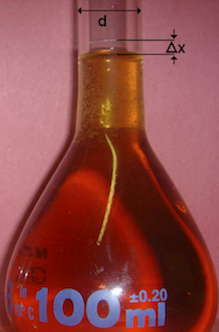Estimating Volume Errors
TOTAL VOLUME ERROR
The total volume error in a piece of glassware is the sum of the (estimated) Fill Error and the Manufacturers Error.
Example: If a flask had a cited Manufacturers Error of ± 0.01 cm3 and the Fill Error had been estimated as ± 0.04 cm3; then the Total (volume) Error would be ± (0.04 + 0.01) cm3 = ± 0.05 cm3
 FILL ERROR - SINGLE FILL GLASSWARE (e.g. volumetric flasks, bulb pipettes)
FILL ERROR - SINGLE FILL GLASSWARE (e.g. volumetric flasks, bulb pipettes)
The Fill Error for this type of glassware should be calculated by:
- Estimating (when you used it least accurately) how far the actual filled level could have been from the fill mark (Δx).
- Estimating the internal diameter of the apparatus at the fill mark (d).
- Using these two values to calculate the volume of a cylinder = π(d/2)2Δx. This is the Fill Error.
Example: If for the volumetric flask shown, you estimated that the difference between the marked fill level and the actual level of liquid (Δx) was 0.3cm and that the diameter (d) of the flask at this point was 1.0cm:
Fill Error = ± π(1.0cm/2)2(0.3cm) = ± 0.24 cm3 = ± 0.24 ml
 FILL ERROR - GRADUATED GLASSWARE (e.g. burettes, measuring cylinders)
FILL ERROR - GRADUATED GLASSWARE (e.g. burettes, measuring cylinders)
The resolution for apparatus where measurements are made using graduations is defined as the smallest variation you can differentiate with certainty (using the graduations).
Example: The measuring cylinder shown has graduations every 0.5ml. If you believed you could (when it was filled) differentiate levels to the nearest graduation the resolution would be 0.5ml; if you believed you could differentiate to half-way between graduations the resolution would be 0.25ml; if to quarter graduations then the resolution would be 0.125ml; etc.
Having established the resolution, the Fill Error is half the resolution.
MANUFACTURERS TOLERANCE (or ERROR) - SINGLE FILL GLASSWARE (e.g. volumetric flasks, bulb pipettes)
Most items of single fill glassware list an uncertainty on them, for example the volumetric flask shown has ±0.20ml indicated on it. This is a manufacturers tolerance (also known as the Manufacturers Error). It typically means that even if the item were filled "perfectly" to a fill point with pure water at a specific temperature (usually 20oC), there would remain this uncertainty in the volume.
If no manufacturers tolerance is listed on the glassware, the value can be looked up using a Table of Standard Values. Note: If neither the manufacturers tolerance or the Class is shown - Assume it is Class B.
MANUFACTURERS TOLERANCE (or ERROR) - GRADUATED GLASSWARE (e.g. burettes, measuring cylinders)
The manufacturers error for graduated glassware should be looked up using a Table of Standard Values. Note: If the Class is not listed on the item - Assume it is Class B.
Important: Although a number that might appear to be a Manufacturers Error is often listed on graduated glassware, it is usually just stating the smallest volume difference between the graduations on the item - Which is not at all equivalent. Therefore, when trying to establish the Manufacturers Error for graduated glassware - Always use a Table of Standard Values.
MANUFACTURERS TOLERANCE (or ERROR) - A Note on Beakers " Conical Flasks
The manufacturers tolerance can/should be ignored if estimating volume errors associated with beakers or conical flasks. For these items the fill error will be so large in comparison to the manufacturers tolerance, that the manufacturers tolerance can be ignored (i.e. assumed to be negligible).
Estimating Errors on Digital Readouts
FLUCTUATING READOUTS
Estimate the range over which the readout is fluctuating. The actual value should be taken as the mid-point of that range, with the associated error being half the range.
Example: If the reading on a balance was fluctuating between 1.017 g and 1.021 g - The value recorded should be ½(1.021+1.017) ± ½(1.021-1.017) = 1.019 ± 0.002 g.
STABLE READOUTS
The resolution of the display is the smallest amount the display can change by and the error is half its resolution.
Example: If a display reading was stable (at 1.8) and the smallest amount the display could change by was 0.1, then the error in the reading would be ± (0.1/2) = ± 0.05.
Warning: Do not assume that the resolution of a digital readout is half its final decimal place - For example there are some auto-pipettes that read to two decimal places (e.g. 2.55 ml) whose resolution is NOT ±(0.01/2)=±0.005ml, but is in fact ±0.025 since the smallest increment the display can change by is 0.05 ml.
Estimating Errors on Spectra
When spectra are obtained it is typically desired to record the position of peaks on the spectrum, along with their associated error. In such cases, the error in the measured peak position should be assumed to equal half the spectrum resolution. The spectrum resolution is the difference between consecutive x-values (at the point where the peak is measured).
Note: It should be possible to save and open the spectrum file so that you can view the numerical x,y data used to plot it. You can then read down the data values until you reach the peak (y-value) you need to estimate the position error on - At this point read the difference (i.e. resolution) between two consecutive x-values.